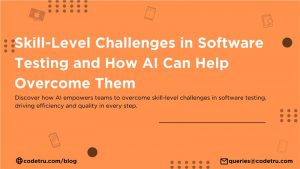Quality Assurance (QA) and software testing play a crucial role in making sure software products are qualitative, secure, and reliable.
They make sure,
To Keep Things Secure: They spot potential security issues early on, so you don’t have to worry about your data being at risk.
To Make Users Happy: By catching bugs and improving performance, they ensure users have a smooth and satisfying experience.
To Identify Risks: QA and testing highlight potential problems before they become major issues, allowing you to address them proactively.
To Encourage Improvement: They provide continuous feedback, helping the development team keep improving the software with each iteration.
The world of QA and software testing keeps on evolving along with the new trends and methodologies evolving for the sake of modern-day software development.
A Few of Such Current Trends are
Automating Test Cases
Now, there’s a growing emphasis on automation for testing, especially for those tasks that are highly repetitive and take significant time to complete, in order to increase both efficiency and accuracy.
CI/CD Integration
Automated testing in a Continuous Integration Continuous Delivery pipe allows tests to be run continuously, which speeds up the process.
AI-Driven Testing
AI and ML will be used to predict possible defects, thus achieving effective test coverage in an automated way.
Generation of Smart Tests: A combination of AI-driven test tools for creating test cases and test results analysis, test recognition of patterns, will be increased several times in their effectiveness.
Make Agile Human
Agile testing approaches are iterative and incremental in nature, which is akin to the overall philosophy behind Agile development. This relates to the continuous process of testing based on stakeholder collaboration, flexibility, and customer feedback.
Shift-left testing, Shift Right testing, DevOps, BDD (Behavior-Driven Development), and TDD (Test-Driven Development) are few more to name.
Here, therefore, are various significant ways that these current trends will impact us and what the future has in store for us:
- Increased Efficiency and Productivity
- Enhanced Test Coverage and Quality
- Improved Collaboration and Communication
- Cost Reduction and Risk Mitigation
- Adapting to Changing User and Business Needs
- Security and Compliance
The future of QA and software testing is bright, driven by AI, automation, and continuous testing. The organizations that take up these trends and methodologies will find themselves in an advantageous position from the development of high-quality software within a short period of time, supporting changes in user behavior, and stay ahead of the competition.
Continuous Innovation: Technology is always subjected to change by introducing different tools and techniques, so the landscape of QA and software testing would change all the time. It is the need for organizations to remain updated with the development so they are competitive and alert.
Skills Development: As testing becomes a more involved process with the application of modern technologies day by day, skills development is a constant need among QA professionals. Training and development programs must be designed to ensure that organizations’ teams are equipped with updated knowledge and capabilities.
Knowledge about current trends with their implementations benefits organizations in improving their QA and software testing processes to enhance software quality and enable business success within current competitive markets.
I am excited to announce the LinkedIn Live event, where I will be speaking about “Elevating Quality: Expert Insights on QA & Software Testing” on June 6th at 10:30 AM EST (8:00 PM IST). As someone deeply passionate about quality assurance and software testing, I’m eager to share my experiences and insights with you all.
During the event, we’ll dive into several key topics, including:
- Emerging Trends
- Tools and Techniques
- Real-world Challenges
- Best Practices in QA
I look forward to seeing you at the event on June 6th. Don’t miss out on this chance to elevate your QA skills. Register now and mark your calendars!
FAQs Latest Trends in QA and Software Testing
1. How does AI impact modern software testing methodologies?
AI revolutionizes software testing by:
Predicting Defects: AI algorithms analyze patterns to anticipate potential issues before they arise.
Enhancing Test Coverage: Machine learning models can identify areas of the application that need more rigorous testing.
Automating Test Creation: AI tools generate and execute test cases, reducing manual effort and increasing efficiency.
Improving Results Analysis: AI-driven analytics provide deeper insights into test outcomes, helping teams understand complex results.
2. What is Shift-Left and Shift-Right Testing, and how do they benefit QA?
Shift-Left Testing: Involves testing earlier in the development cycle to identify and fix defects sooner. Benefits include reduced cost of fixing issues and faster feedback loops.
Shift-Right Testing: Focuses on testing in the production environment to ensure real-world performance and reliability. It helps in identifying user experience issues and maintaining application stability post-deployment.
3. How can Continuous Integration and Continuous Delivery (CI/CD) pipelines improve software quality?
CI/CD pipelines enhance software quality by:
Automated Testing: Running tests automatically at various stages of development ensures that defects are caught early.
Frequent Releases: Regular updates and deployments allow for quick fixes and enhancements based on user feedback.
Consistency and Efficiency: CI/CD practices streamline the development process, ensuring consistent quality and reducing the likelihood of integration issues.
4. What skills should QA professionals develop to keep up with evolving testing methodologies?
QA professionals should focus on:
Advanced Automation Techniques: Gaining expertise in using automation tools and writing automated test scripts.
AI and Machine Learning: Understanding how to apply AI and ML in testing to enhance accuracy and efficiency.
Agile and DevOps Practices: Developing skills in Agile methodologies and DevOps to integrate testing seamlessly into the development process.
Continuous Learning: Staying updated with the latest tools, technologies, and best practices through ongoing training and professional development.
6. How can integrating AI and automation into QA processes reduce costs and improve outcomes?
Integrating AI and automation into QA processes can significantly reduce costs and improve outcomes by:
Reducing Manual Effort: Automation handles repetitive and time-consuming tasks, allowing QA teams to focus on more strategic activities.
Enhancing Test Accuracy: AI-driven tools minimize human error, providing more reliable and consistent test results.
Accelerating Testing Cycles: Automated tests run faster and more frequently, leading to quicker identification and resolution of issues.
Optimizing Resource Allocation: By automating routine tasks, organizations can allocate resources more efficiently, lowering operational costs and increasing overall productivity.







